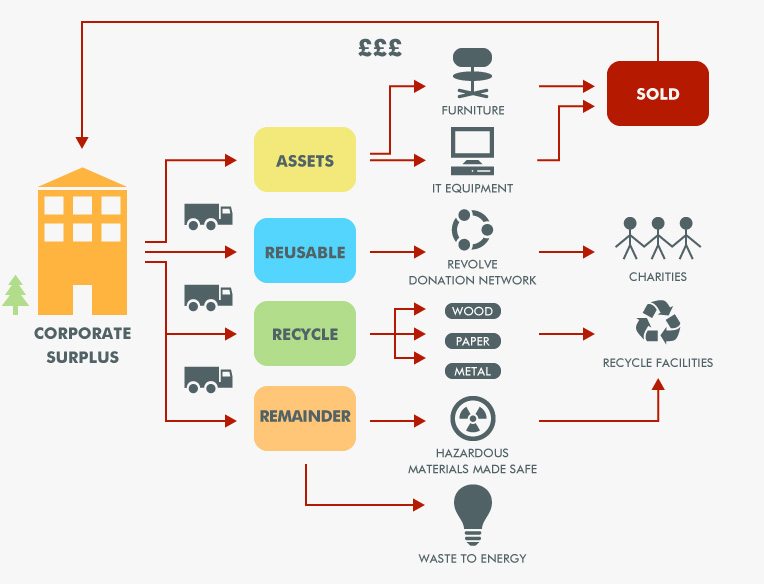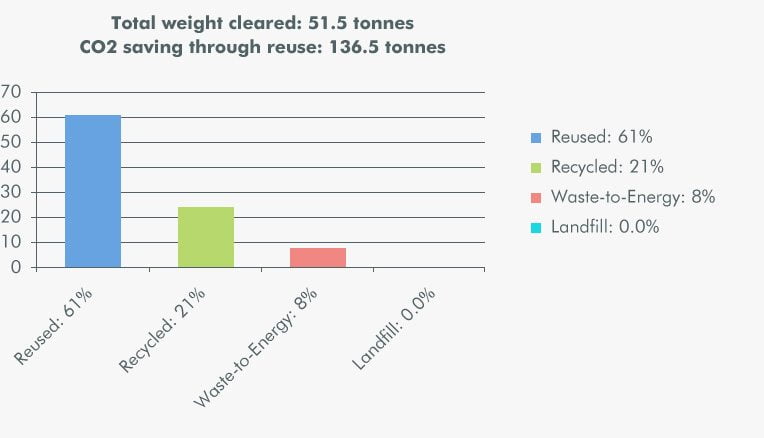Sustainability (and fulfilling your Duty of Care)
Clearance Solutions provide the complete sustainable clearance services – in alignment with your values and Corporate Social Responsibility objectives.
By helping you transform the management of your redundant and surplus materials, we deliver environmental and social benefits, and ensure you fulfill your Duty of Care.
Your Duty of Care and the Waste Hierarchy
If you have waste, you have a legal Duty of Care to ensure it is discarded appropriately. The Duty of Care applies to all materials you discard, regardless of whether they are resold or recycled.
If you instruct a contractor to dispose of waste from your site, you must ensure that:-
a) The contractor has the means to take it
b) The waste goes to an appropriate site
c) You issue a Waste Transfer Notice (WTN)
d) A declaration is signed on the WTN to indicate that the Waste Hierarchy has been thoroughly
applied.
We do all the above on your behalf. We implement the Waste Hierarchy to the fullest extent possible. This results in high rates of reuse and recycling, and sustainable treatment of all materials.
The process – Achieving sustainable clearances
The key to providing a cost effective, ethical and green service is separating the materials as they are removed from site into the following categories:
1. Assets that can be resold
We buy a wide range of assets, including suitable furniture, IT, machinery and equipment, and offset the revenue generated against any cost of clearing materials with no value.
2. Re-useable furniture that can be donated
Items that have low or negligible resale value in the second-hand market, but are in good working order and are useful, are donated to charities and other good causes.
3. Recyclable materials
Items that can’t be reused, such as incomplete and broken furniture, waste paper products, old containers etc are taken to dedicated recycling facilities.
4. A commitment to zero landfill
Items that can’t be recycled, such reconstituted wood products (chip board and MDF) are broken down and made into pellets to be used as fuel in Waste-to-Energy plants. Hazardous materials such paint, fridges, florescent bulb and plasterboards are taken to facilities where they are treated and made safe prior to recycling or disposal

Environmental benefits
Reuse is by far the ‘greenest’ solution for redundant and surplus materials. It results in significant CO2 savings (far more than recycling), and diverts materials from landfill.
Environmental reporting
Our post project Environmental Reports calculate the CO2 saved through reuse. The methodology is based on Dr Adrian Chapman work published by The Centre for Remanufacture and Reuse.
In addition to the CO2 saved through re-use, our reports detail the total quantities of:-
1. Materials removed from site
2. Materials reused
3. Materials recycled
4. Materials used in energy recovery
5. Materials disposed of by other means
Below is an extract from one of our recent reports.
Client: University of Creative Arts

Clear audit trail
We supply a full audit trail, detailing where all the materials cleared have gone. In addition to the statutory Waste Transfer Notices, we provide documentation to support the results given in our Environmental Reports. This includes details of organisations and individuals who either bought or received donations, and the quantities sold or donated to them.
To find out more about our sustainable approach, please call
020 7706 7554 or email rufus@clearance-solutions.co.uk











